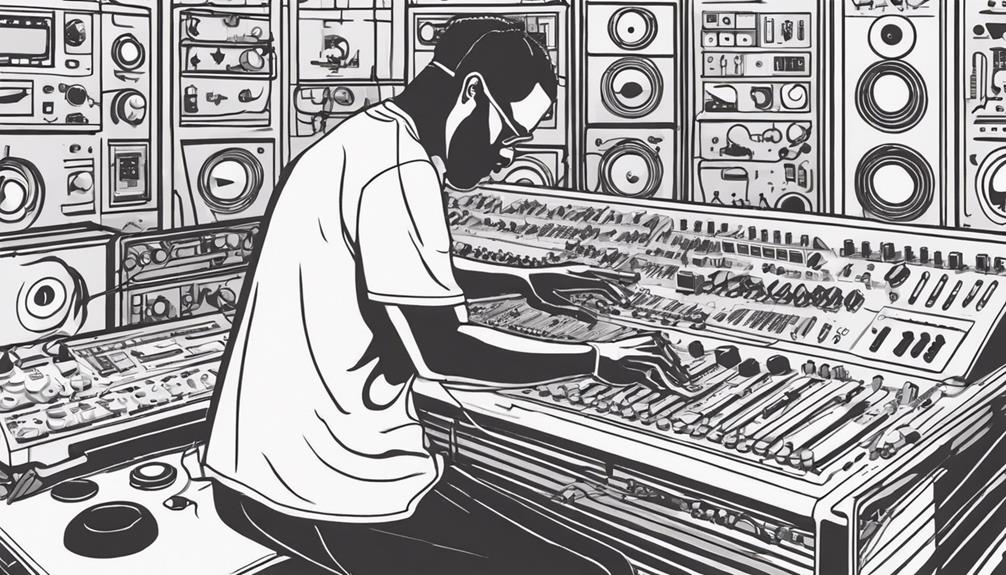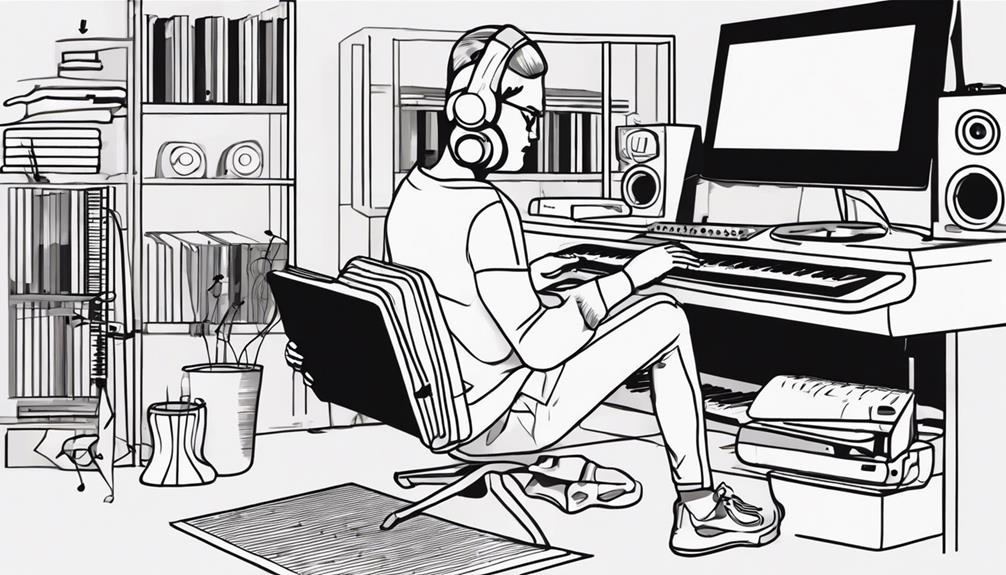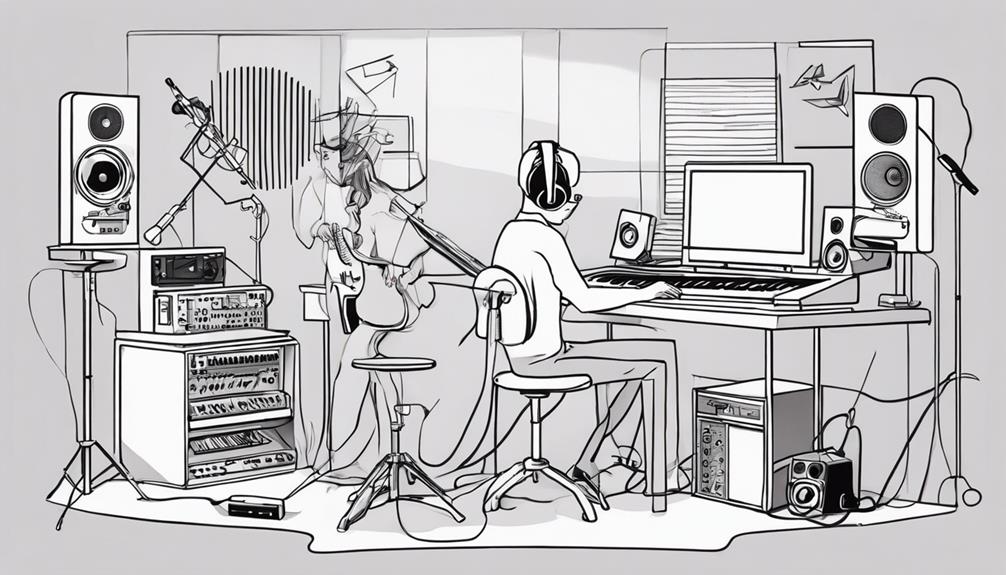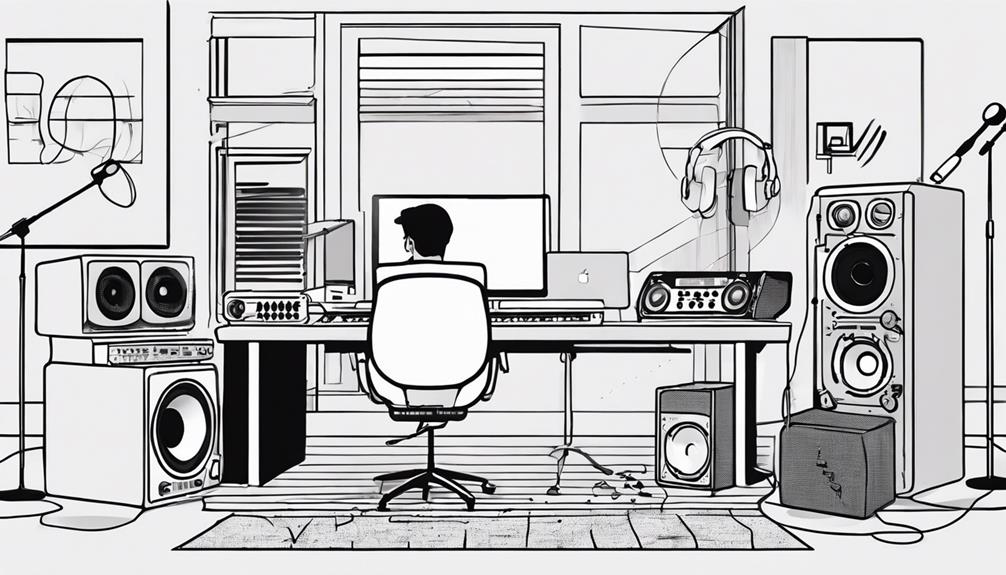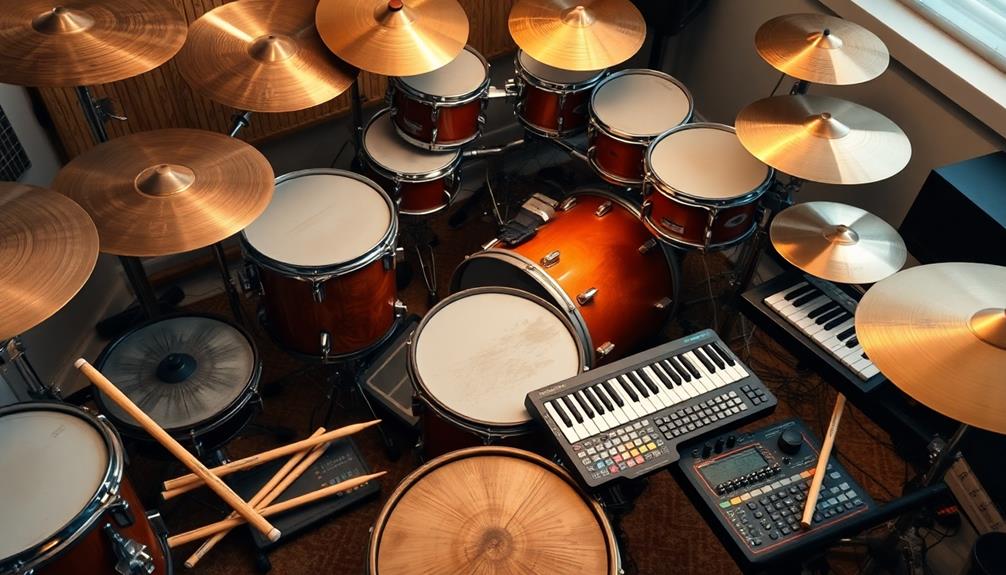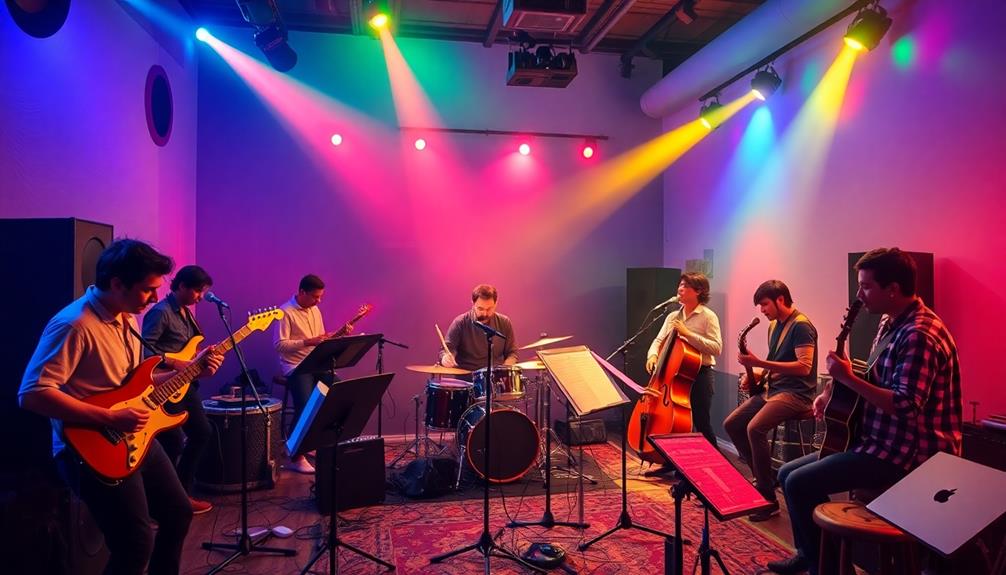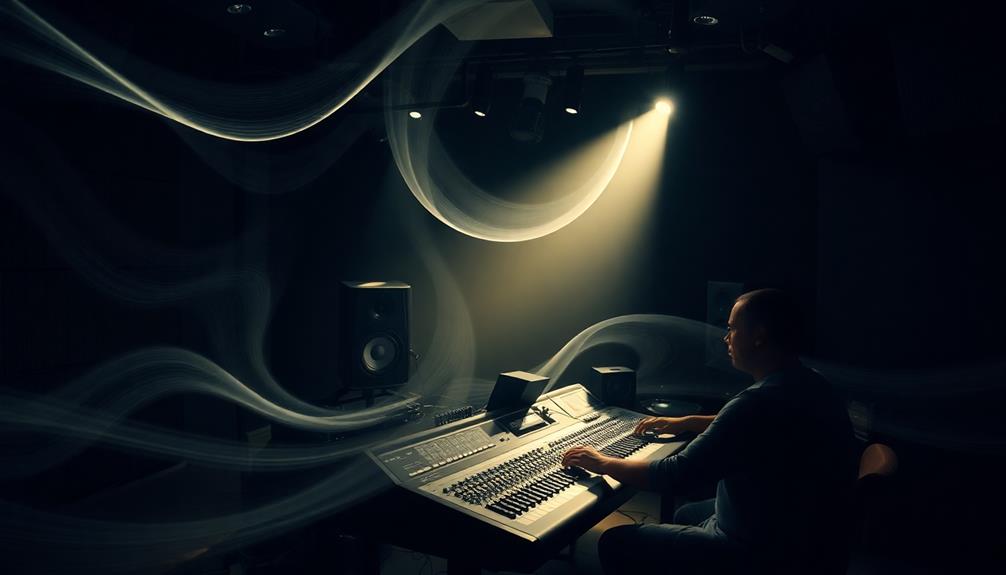To make music production beats that stand out, use essential tools like sample libraries and DAW software. Build a solid bass foundation by layering elements and experimenting with bass notes. Choose between samples and synths for character and creativity. Elevate your beats with breakbeats for unique rhythms. Master beatmaking techniques, define your beat's vibe, add drum elements, and enhance with melodic elements. Using these tips and techniques will help you create engaging tracks that resonate with your audience.
Key Takeaways
- Layer drum elements for depth and impact.
- Experiment with diverse samples and synths.
- Utilize breakbeats for unique rhythms.
- Refine sound with filtering techniques.
- Craft melodies in key for coherence.
Essential Tools for Beat Making
To create high-quality beats, you need essential tools like sample libraries, DAW software, beat sequencers, MIDI controllers, and mixing/mastering software.
Sample libraries such as Splice and Sounds.com offer a diverse range of high-quality sounds to enhance your beats. These libraries provide a plethora of options for drum samples, basslines, and melodies to elevate your sound.
DAW software like Logic Pro X and Ableton Live is important for recording and editing beats, allowing you to fine-tune every element of your production.
Beat sequencers like BreakTweaker are instrumental in arranging samples and creating unique rhythms for your tracks.
MIDI controllers play an important role in adding dynamic elements to your beats, especially for drum grooves and intricate patterns. Additionally, utilizing virtual instruments through MIDI controllers can bring a new dimension to your sound.
Moreover, mixing and mastering software such as Neutron and Ozone are necessary for polishing your beats and ensuring they sound professional and cohesive. These tools help enhance the overall quality of your production, making your beats stand out in the competitive music industry.
Crafting a Solid Bass Foundation
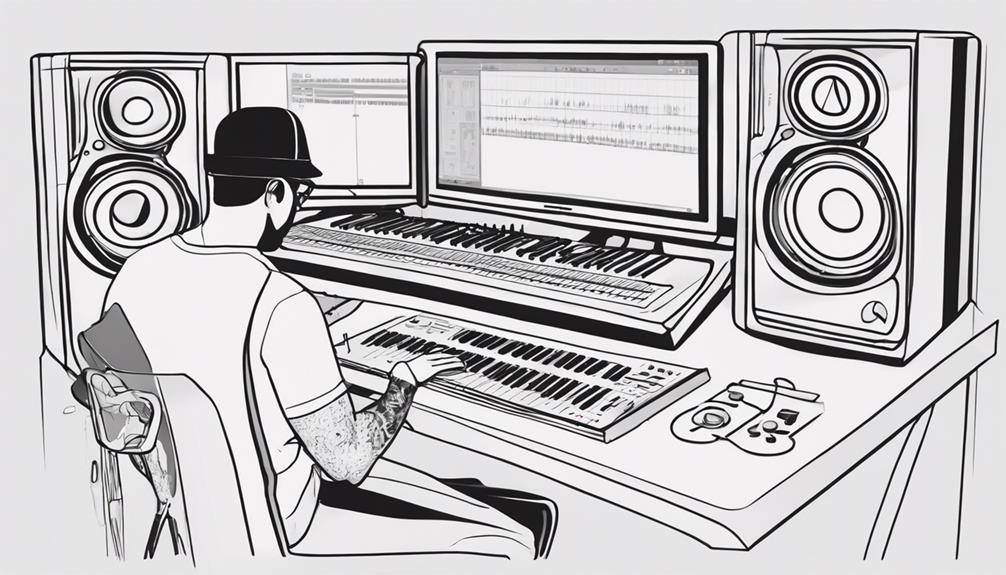
You know that the bassline is essential for setting the rhythm and harmony in your beats.
Layering different bass elements can add richness and depth to your track, enhancing its overall groove and feel.
Let's explore how crafting a solid bass foundation can take your music production to the next level. A strong bassline not only provides depth but also serves as the backbone of any track, anchoring other elements and enhancing overall groove. By experimenting with layering techniques, EQ adjustments, and sidechain compression, you can create a dynamic and impactful low end that resonates with listeners. For more advanced music production tips, consider integrating creative modulation or distortion to add texture and character to your basslines, elevating your tracks to a professional level. To truly master bass music production techniques, focus on understanding the interaction between your bassline and kick drum to maintain clarity and punch. Additionally, utilize automation creatively to introduce subtle movements, ensuring your bass remains dynamic and captivating throughout the track. By refining these details, you can transform an ordinary mix into one that stands out in both energy and complexity.
Bassline Importance
Crafting a solid bass foundation is essential for creating impactful music production beats, providing a strong rhythmic and harmonic backbone. The bassline serves as the heartbeat of your track, dictating the groove and feel while amplifying the energy and depth of the beat. By experimenting with various bass patterns, tones, and rhythms, you can uncover the perfect fit that enhances the overall impact of your music. Balancing the bassline with other elements such as drums and melodies is vital for achieving a cohesive sound that resonates with your audience.
| Bassline Importance | |
|---|---|
| Rhythmic Backbone | Determines groove and feel |
| Harmonic Foundation | Enhances energy and depth |
| Impact on Beat | Drives track and engages listeners |
| Experimentation | Find the perfect fit |
| Balancing Elements | Achieve a cohesive sound |
Layering Bass Elements
Layering different bass elements in beats creates a rich and impactful foundation for your music production. By combining various bass instruments such as synth bass, sub bass, and live bass recordings, you can add depth and texture to your beat. This layering technique helps fill out the low-end frequencies, enhancing the overall groove and energy of the track.
To craft a solid bass foundation, experiment with EQ, compression, and effects on each bass layer. Adjusting the EQ can carve out space for each bass element, while compression can help glue them together for a cohesive sound. Applying effects strategically can further enhance the texture and character of the bass elements.
Properly mixing and balancing the layered bass elements is essential. Make sure that each bass sound complements the others and works harmoniously within the beat. By paying attention to detail in the mixing process, you can create a powerful and well-rounded bass foundation for your music production.
Experimenting With Bass Notes
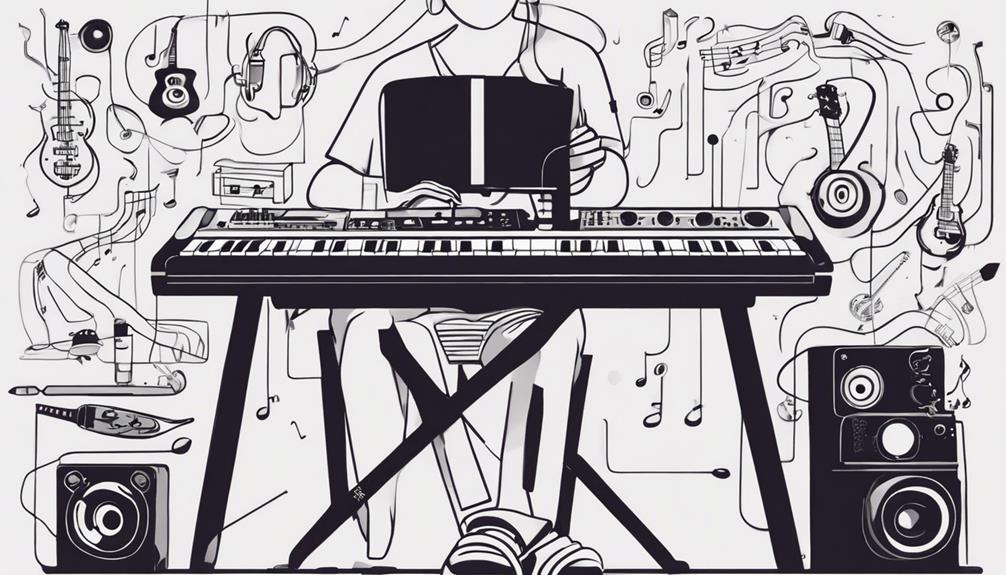
When exploring music production beats, experimenting with various bass notes can greatly impact the overall texture and atmosphere of your composition.
By trying out different bass notes, you can create unique textures and atmospheres in your beats.
Aligning the bass note with the lead instrument is essential as it enhances the harmony and groove of the track.
Varying bass notes not only adds depth and complexity but also allows you to evoke different emotions and moods within your music.
Changing the root note of the bass can greatly influence the energy and feel of the track, giving it a fresh perspective.
Mixing up your bass notes keeps the beat engaging for your listeners, ensuring that they stay captivated throughout the entire piece.
Experimentation with bass notes is a powerful tool in your music production arsenal, offering endless possibilities for crafting dynamic and compelling beats.
Utilizing Samples Vs. Synths
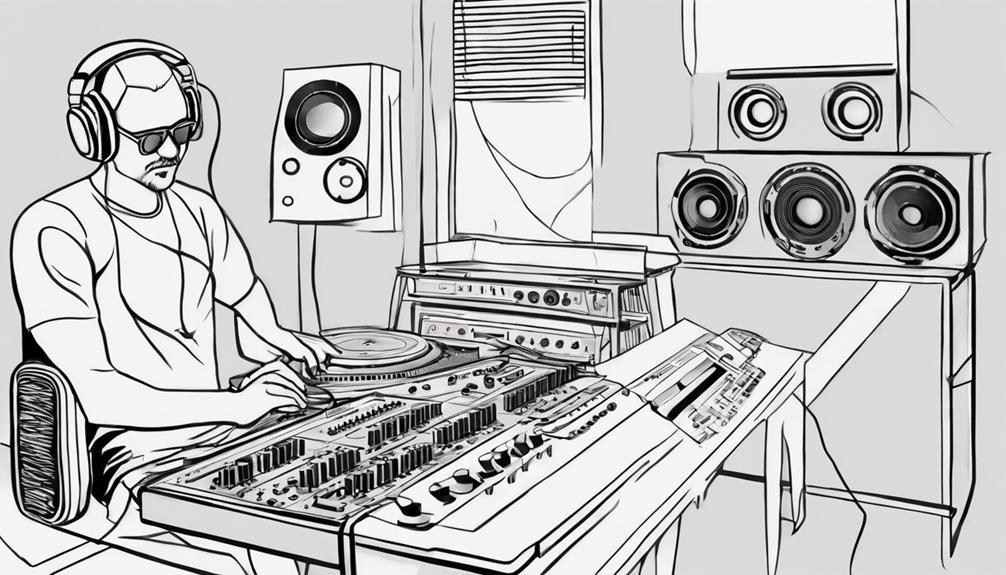
Using samples or synths in your music production beats provides distinct advantages and creative opportunities for enhancing your sound. Sampling involves incorporating segments of existing music, adding character and nostalgia to your beats. On the other hand, synths offer endless sound possibilities without the need for legal clearance, allowing for more creative experimentation. In the table below, you can see some key points comparing the use of samples and synths in beatmaking:
| Aspect | Samples | Synths |
|---|---|---|
| Legal Requirements | Require legal clearance for commercial use | No legal clearance needed |
| Sound Variety | Limited to existing samples | Endless sound possibilities |
| Creative Freedom | Enhances with nostalgia and character | Allows for extensive creative experimentation |
Both sampling and synths play significant roles in music production, especially in genres like Hip Hop, where famous breakbeats are often utilized to enhance rhythmic patterns. Additionally, filtering techniques can be applied to both samples and synths to help them blend seamlessly in the mix, resulting in a polished sound.
Elevating Beats With Breakbeats
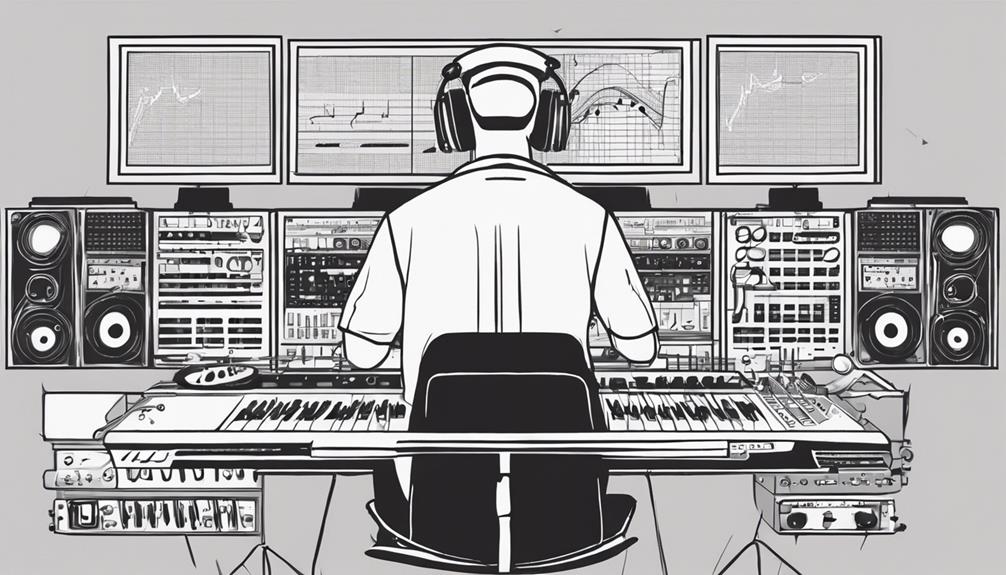
To enhance your beats, consider incorporating breakbeats as a foundational element. By understanding breakbeat basics and mastering the art of mixing breakbeats, you can elevate your productions to new heights.
Experimenting with breakbeats allows you to infuse your tracks with a timeless and engaging rhythm.
Breakbeat Basics
Elevating beats with breakbeats involves integrating sampled drum loops to infuse your music production with a vintage and authentic touch. Breakbeats, commonly used in genres like Hip Hop and electronic music, are the foundation of many iconic tracks. These drum loops, often chopped and manipulated, serve as a rhythmic backbone, providing groove and character to your beats. By sampling breakbeats, you can create unique rhythmic patterns and variations, adding depth and nostalgia to your music.
To better understand breakbeat basics, take a look at the table below:
| Breakbeat Basics | Description |
|---|---|
| Sampling | Utilizing existing drum loops from songs to create new rhythmic elements |
| Chopping | Breaking down the loops into smaller segments for manipulation |
| Manipulation | Tweaking the loops by adding effects, adjusting tempo, or rearranging |
| Rhythmic Patterns | Creating unique rhythms by combining and layering different breakbeats |
| Authenticity | Infusing your tracks with a vintage feel by incorporating classic breakbeats |
Mixing Breakbeats
Integrating breakbeats into your music production beats can greatly enhance their depth and character. Breakbeats, such as the famous 'Amen Break,' are iconic drum loops often sampled in hip-hop and electronic music. These breaks inject a vintage and nostalgic feel into modern beats, adding authenticity and a unique touch.
When mixing breakbeats, consider layering them with original drum patterns to create dynamic and creative rhythms. By blending these classic elements with your own sounds, you can achieve a balance between tradition and innovation.
Experimenting with breakbeats provides a solid foundation for beatmaking, allowing you to explore different styles and push the boundaries of your music. The intricate textures and nuances of breakbeats can elevate the overall quality of your tracks, giving them a timeless appeal.
Embrace the creativity that mixing breakbeats offers, and watch as your music production beats transform with a touch of retro charm and authenticity.
Refining Sounds With Filtering Techniques
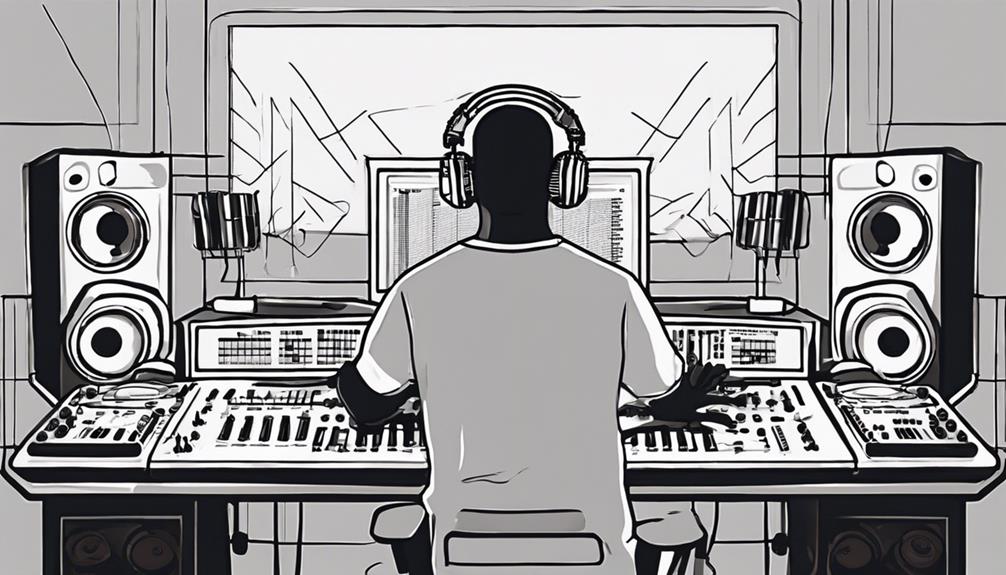
Enhance your music production beats by skillfully refining sounds through various filtering techniques. Filtering involves adjusting the frequency content of audio signals to shape the timbre, tone, and character of your music.
Here are some key filtering techniques worth exploring:
- High Pass filters: Eliminate low frequencies from your sounds, providing clarity and reducing muddiness.
- Low Pass filters: Cut out high frequencies, creating a warmer and more subdued sound.
- Band Pass filters: Allow a specific range of frequencies to pass through, focusing on a particular sonic range.
- Notch filters: Target and remove specific frequencies, helping to clean up unwanted resonances or frequencies.
- Shaping timbre: Experiment with different filter types and settings to sculpt the overall sonic quality and texture of your beats.
Mastering the Art of Beatmaking
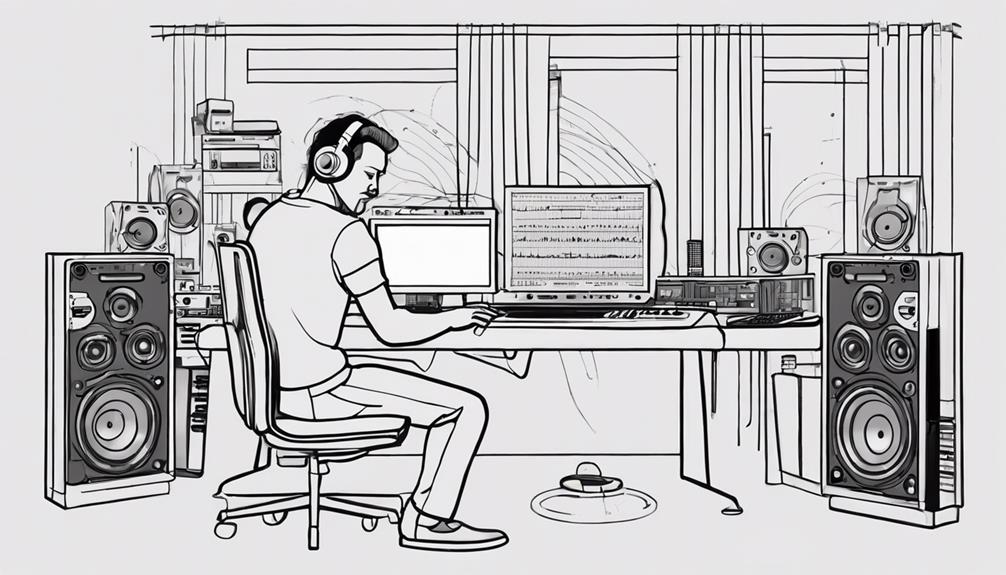
You're ready to elevate your beatmaking skills by mastering beat structure techniques and refining your sampling and sequencing methods.
By understanding how to create dynamic rhythmic patterns and arrange musical elements effectively, you can craft beats that stand out.
Experimenting with different samples, synths, and drum loops will help you develop a unique sound and push the boundaries of your creativity.
Beat Structure Techniques
Mastering the art of beatmaking involves understanding and implementing effective beat structure techniques.
To create engaging beats, you must focus on the arrangement, tension and release, variations, breakdowns, drops, build-ups, and coherent flow. Here's a breakdown to help you master these techniques:
- Arrangement: Properly organizing elements like drums, bass, and melody is essential for a cohesive beat.
- Tension and Release: Building up anticipation through different sections like intro, verse, chorus, and bridge keeps listeners interested.
- Variations: Adding diverse drum patterns, melodies, and effects injects excitement and dynamics into your beat.
- Breakdowns, Drops, and Build-ups: Incorporating these elements elevates the energy and impact of your beat.
- Coherent Flow: Ensuring a smooth and logical progression throughout the beat guides the listener on a musical journey.
Sampling and Sequencing
When crafting beats, a key aspect to focus on is mastering the art of sampling and sequencing. Sampling involves taking segments of existing music or sounds to create new beats or compositions, while sequencing is arranging and layering samples, instruments, and sounds to create a cohesive musical piece. These techniques are fundamental in beatmaking and play a crucial role in crafting unique and engaging music productions. Sampling allows producers to incorporate iconic sounds or melodies into their beats, adding depth and character. On the other hand, sequencing helps producers structure their beats, control the flow of the music, and create dynamic arrangements. By mastering the skills of sampling and sequencing, producers can elevate their music production to new heights, making their beats stand out and resonate with listeners.
| Sampling | Sequencing |
|---|---|
| Utilizes existing music or sounds | Arranges and layers samples, instruments, and sounds |
| Adds depth and character to beats | Creates dynamic arrangements |
| Key technique in beatmaking | Essential for structuring beats |
| Incorporates iconic sounds or melodies | Controls the flow of the music |
Defining Your Beat's Vibe
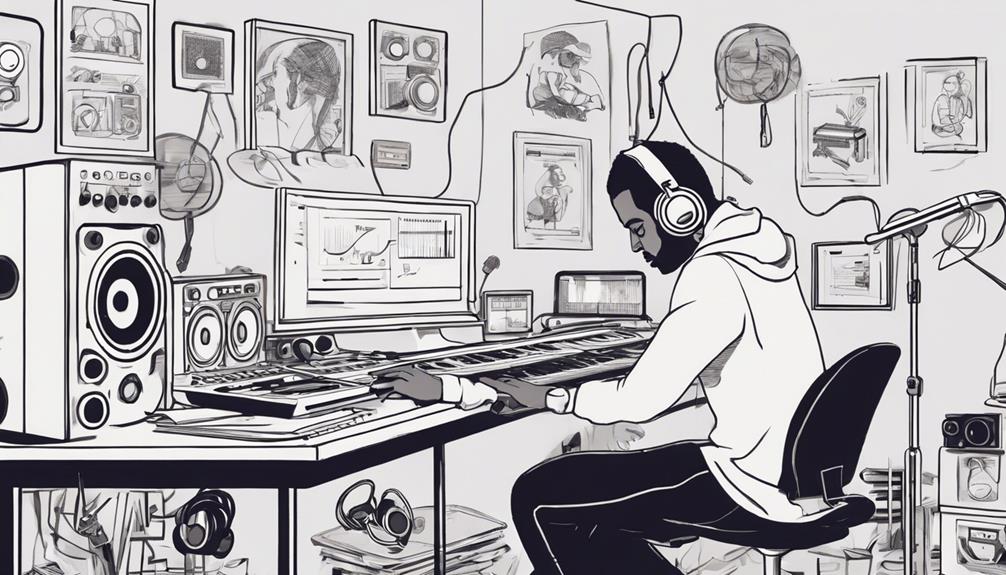
To define the vibe of your beat effectively, start by setting the mood, tempo, and overall feel of the track. Consider your target audience and genre preferences to guarantee a coherent sound. Experiment with melodies, harmonies, and rhythms to align with the defined vibe and evoke the desired emotions in your listeners.
The emotional impact of a beat is heavily influenced by its vibe, so establishing a clear direction from the beginning is essential. Clarity in defining your beat's vibe won't only guide your creative process but also streamline the production, resulting in a more engaging final product.
- Set the Mood: Determine whether you want your beat to be energetic, soothing, upbeat, or melancholic.
- Choose the Tempo: Decide on a tempo that complements the vibe you want to create, whether it's fast-paced, mid-tempo, or slow.
- Consider Genre Preferences: Tailor your beat's vibe to match the expectations and conventions of the specific genre you're working in.
- Experiment with Melodies: Create catchy and memorable melodies that resonate with the overall feel of your beat.
- Play with Harmonies and Rhythms: Incorporate harmonies and rhythms that enhance the vibe you're aiming for and add depth to your beat.
Adding Drum Elements
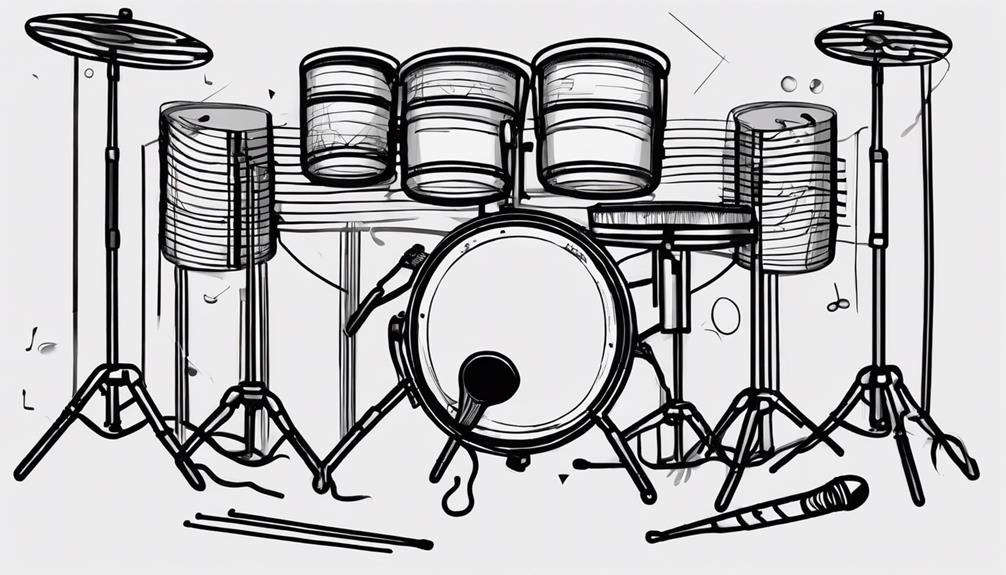
Enhance your beat's rhythm and groove by incorporating essential drum elements like kicks, snares, and hi-hats. These drum elements serve as the backbone of your beat, providing the foundation for your music production.
Consider layering different drum sounds to add depth and complexity to your beat. Experiment with various drum patterns and variations to make your beat more dynamic and engaging.
Introduce percussion instruments such as shakers, tambourines, or congas to enhance the overall texture of your beat and infuse it with unique flavors. Adding drum fills and shifts at strategic points can create excitement and movement within your beat, keeping your listeners engaged.
Enhancing Beats With Melodic Elements
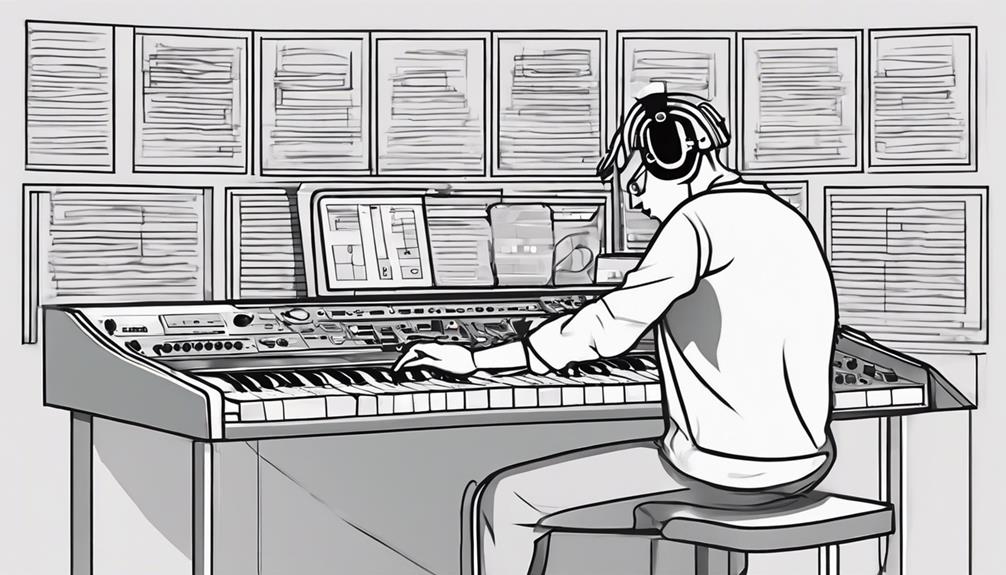
Melodic elements play a significant role in enhancing the depth and emotional impact of your beats.
When enhancing your beats with melodic elements, consider choosing elements that are in the same key as your track to maintain harmony and cohesion.
Experimenting with different instruments for melodies can add variety and interest, elevating the overall sound of your beat.
Utilizing fill-ins with melodic elements strategically can create smooth connections between different sections of your beat, helping to guide the listener through the music.
Additionally, adding multiple melodic layers can increase the complexity and richness of your beat, making it more engaging and dynamic.
Frequently Asked Questions
How to Get Better at Creating Beats?
To get better at creating beats, you should practice regularly, collaborate with others, experiment with genres, stay updated on trends, analyze producers' works, and deepen your knowledge in audio processing, music theory, and production techniques.
How to Make a Beat Step by Step?
Want to make a beat step by step? Start by defining the vibe and tempo. Craft a killer bassline with echoes, layer drums for unique rhythms, add melodic elements, and foley. Finally, polish it up with dynamics and structure.
How Should a Beat Be Structured?
To structure a beat effectively, start with an intro, verse, chorus, bridge, and outro. Each section needs unique elements like drum patterns and melodies. Arrange musical elements logically, and add variation for dynamics and interest.
What Is the Thing That Producers Use to Make Beats?
To make beats, producers use Digital Audio Workstations (DAWs) like Ableton Live and FL Studio. They also rely on MIDI controllers with pads and keys, sample libraries such as Splice, beat sequencers like BreakTweaker, and mixing/mastering software for quality production.
Conclusion
Now that you have learned some essential tips and techniques for making music production beats, it's time to put them into practice and start creating your own unique sound.
Just like rising producer Sarah, who used breakbeats to add depth and energy to her tracks, you too can elevate your music by experimenting and refining your beatmaking skills.
So grab your tools, get creative, and let your beats speak for themselves!

